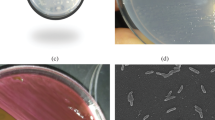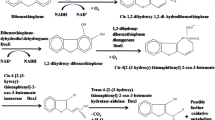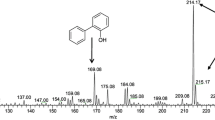Abstract
Purpose
Biodesulfurization (BDS) has the potential to desulfurize dibenzothiophene (DBT) and its alkylated derivatives, the compounds that are otherwise refractory to hydrodesulfurization (HDS). Thermophilic microorganisms are more appropriate to be used for BDS applications following HDS. The aim of the present study was to isolate a thermophilic microorganism and to explore its commercial relevance for BDS process.
Methods
The desulfurizing thermophilic strain was isolated and enriched from various soil and water samples using sulfur free medium (SFM) supplemented with DBT. Microbiological and genomic approach was used to characterize the strain. Desulfurization reactions were carried out using DBT and petroleum oils at 45°C followed by different analytical procedures.
Results
We report the isolation of a thermophilic bacterium Klebsiella sp. 13T from contaminated soils collected from petroleum refinery. HPLC analysis revealed that Klebsiella sp. 13T could desulfurize DBT to 2-hydroxybiphenyl (2-HBP) at 45°C through 4S pathway. In addition, adapted cells of Klebsiella sp. 13T were found to remove 22–53% of sulfur from different petroleum oils with highest sulfur removal from light crude oil.
Conclusion
Klebsiella sp. 13T is a potential candidate for BDS because of its thermophilic nature and capability to desulfurize petroleum oils.



Similar content being viewed by others
Abbreviations
- HDS:
-
Hydrodesulfurisation
- BDS:
-
Biocatalytic desulfurization
- DBT:
-
Dibenzothiophene
- SFM:
-
Sulfur free medium
- 2-HBP:
-
2-Hydroxybiphenyl
References
Altschul SF, Gish W, Miller W, Myers EW, Lipman DJ (1990) Basic local alignment search tool. J Mol Biol 215:403–410
Bhatia S, Sharma DK (2006) Emerging role of biorefining of heavier crude oils and integration of biorefining with petroleum refineries in future. Petrol Sci Technol 24:1125–1159
Bhatia S, Sharma DK (2010a) Mining of genomic databases to identify novel biodesulfurizing microorganisms. J Ind Microbiol Biotechnol 37:425–429
Bhatia S, Sharma DK (2010b) Biodesulfurization of dibenzothiophene, its alkylated derivatives and crude oil by a newly isolated strain Pantoea agglomerans D23W3. Biochem Eng J 50:104–109
Chang JH, Chang YK, Ryu HW, Chang HN (2000) Desulfurization of light gas oil in immobilized cell systems of Gordona sp. CYKS1 and Nocardia CYKS2. FEMS Microbiol Lett 182:309
Chen H, Cai YB, Zhang WJ, Li W (2009) Methoxylation pathway in biodesulfurization of model organosulfur compounds with Mycobacterium sp. Bioresour Technol 100:2085–2087
Denis-Larose C, Labbe D, Bergeron H, Jones AM, Greer CW, Al-Hawari J, Grossman MJ, Sankey BM, Lau PC (1997) Conservation of plasmid-encoded dibenzothiophene desulfurization genes in several rhodococci. Appl Environ Microbiol 63:2915–2919
Duarte GF, Rosado AS, Seldin L, de Araujo W, van Elsas JD (2001) Analysis of bacterial community structure in sulfurous-oil-containing soils and detection of species carrying dibenzothiophene desulfurization (dsz) genes. Appl Environ Microbiol 67:1052–1062
Dudley MW, Frost JW (1994) Biocatalytic desulfurization of arylsulfonates. Bioorg Med Chem 2:681
Furuya T, Kirimura K, Kino K, Usami S (2001) Thermophilic desulfurization of dibenzothiophene and its derivatives by Mycobacterium pheli WUF-1. FEMS Microbiol Lett 204:129–133
Furuya T, Ishii Y, Noda K, Kino K, Kirimura K (2003) Thermophilic biodesulfurization of hydrodesulfurized light gas oils by Mycobacterium phlei WU-F1. FEMS Microbiol Lett 221:137
Gallagher JR, Olson ES, Stanley DC (1993) Microbial desulphurisation of dibenzothiophene: a sulfur-specific pathway. FEMS Microbiol Lett 107:31–36
Gray KA, Mrachkoyz GT, Squiresy CH (2003) Biodesulfurization of fossil fuels. Curr Opin Microbiol 6:229–235
Gupta N, Roychoudhury PK, Deb JK (2005) Biotechnology of desulfurization of diesel: prospects and challenges. Appl Microbiol Biotechnol 66:356–366
Ishii Y, Kozaki S, Furuya T, Kino K, Kirimura K (2005) Thermophilic biodesulfurization of various heterocyclic sulfur compounds and crude straight-run light gas oil fraction by a newly isolated strain Mycobacterium phlei WU-0103. Curr Microbiol 50:63–70
Kayser KJ, Cleveland L, Park H, Kwak J, Kolhatkar A, Kilbane JJ (2002) Isolation and characterization of a moderate thermophile, Mycobacterium phlei GTIS10 capable of dibenzothiophene desulfurization. Appl Microbiol Biotechnol 59:737–746
Kirimura K, Furuya T, Nishii Y, Ishii Y, Kino K, Usami S (2001) Biodesulfurization of dibenzothiophene and its derivatives through the selective cleavage of carbon–sulfur bonds by a moderately theromophillic bacterium Bacillus subtilis WU-S2B. J Biosci Bioeng 91:262–266
Kobayashi M, Onaka T, Ishii Y, Konishi J, Takaki M, Okada H, Ohta Y, Koizumi K, Suzuki M (2000) Desulfurization of alkylated forms of both dibenzothiophene and benzothiophene by a single bacterial strain. FEMS Microbiol Lett 187:123–126
Konishi J, Ishii Y, Onaka T, Okumura K, Suzuki M (1997) Thermophilic carbon–sulfur-bond targeted biodesulfurization. Appl Environ Microbiol 63:3164
Konishi J, Onaka T, Ishii Y, Suzuki M (2000) Demonstration of the carbon–sulfur bond targeted desulfurization of benzothiophene by thermophilic Paenibacillus sp. strain A11-2 capable of desulfurizing dibenzothiophene. FEMS Microbiol Lett 187:151–154
Li FL, Xu P, Ma CQ, Luo LL, Wang XS (2003) Deep desulfurization of hydrodesulfurization-treated diesel oil by a facultative thermophilic bacterium Mycobacterium sp. X7B. FEMS Microbiol Lett 223:301–307
Li W, Zhang Y, Wang MD, Shi Y (2005) Biodesulfurization of dibenzothiophene and other organic sulfur compounds by a newly isolated Microbacterium strain ZD-M2. FEMS Microbiol Lett 247:45–50
Li F, Zhang Z, Feng J, Cai X, Xu P (2007) Biodesulfurization of DBT in tetradecane and crude oil by a facultative thermophilic bacterium Mycobacterium goodii X7B. J Biotechnol 127:222–228
Maghsoudi S, Vossoughi M, Kheirolomoom A, Tanaka E, Katoh S (2001) Biodesulfurization of hydrocarbons and diesel fuels by Rhodococcus sp. strain P32C1. Biochem Eng J 8:151
Mohebali G, Ball AS (2008) Biocatalytic desulfurization (BDS) of petrodiesel fuels. Microbiology 154:2169–2183
Monticello DJ (2000) Biodesulfurization and upgrading of petroleum distillates. Curr Opin Biotechnol 11:540–546
Oldfield C, Pogrebinsky O, Simmonds J, Olson ES, Kulpa CF (1997) Elucidation of the metabolic pathway for dibenzothiophene desulphurization by Rhodococcus sp. strain IGTS8 (ATCC 53968). Microbiology 143:2961–2973
Rawlings, DE (1995) Restriction enzyme analysis of 16S rRNA genes for the rapid identification of Thiobacillus ferrooxidans, Thiobacillus thiooxidans and Leptospirillum ferooxidans strains in leaching environments. In: Jerez V, Toledo W (eds) Biohydrometallurgical processing. Proceedings of the International Biohydrometallurgical Symposium (vol II), Chile, p 9
Soleimani M, Bassi A, Margaritis A (2007) Biodesulfurization of refractory organic sulfur compounds in fossil fuels. Biotechnol Adv 25:570–596
Yu B, Xu P, Shi Q, Ma C (2006) Deep desulfurization of diesel oil and crude oils by a newly isolated Rhodococcus erythropolis strain. Appl Environ Microbiol 72:54–58
Zhou ZY, Zhang K (2004) Development situation and prospect of oil fields in China. Petroleum Expl Dev 31:84–87
Acknowledgements
This work was supported by the grant from the Petroleum Conservation Research Association (PCRA), Ministry of Petroleum & Natural Gas, Government of India, India. The authors are thankful to Dr. H.K. Prasad for helping in genomic DNA isolation and PCR analysis. The gift of R. erythropolis IGTS8 from Dr. J. Kilbane is greatly acknowledged. We are also thankful to Panipat Refinery for carrying out XRF analysis.
Author information
Authors and Affiliations
Corresponding authors
Additional information
Responsible editor: Philippe Garrigues
Rights and permissions
About this article
Cite this article
Bhatia, S., Sharma, D.K. Thermophilic desulfurization of dibenzothiophene and different petroleum oils by Klebsiella sp. 13T. Environ Sci Pollut Res 19, 3491–3497 (2012). https://doi.org/10.1007/s11356-012-0884-2
Received:
Accepted:
Published:
Issue Date:
DOI: https://doi.org/10.1007/s11356-012-0884-2




